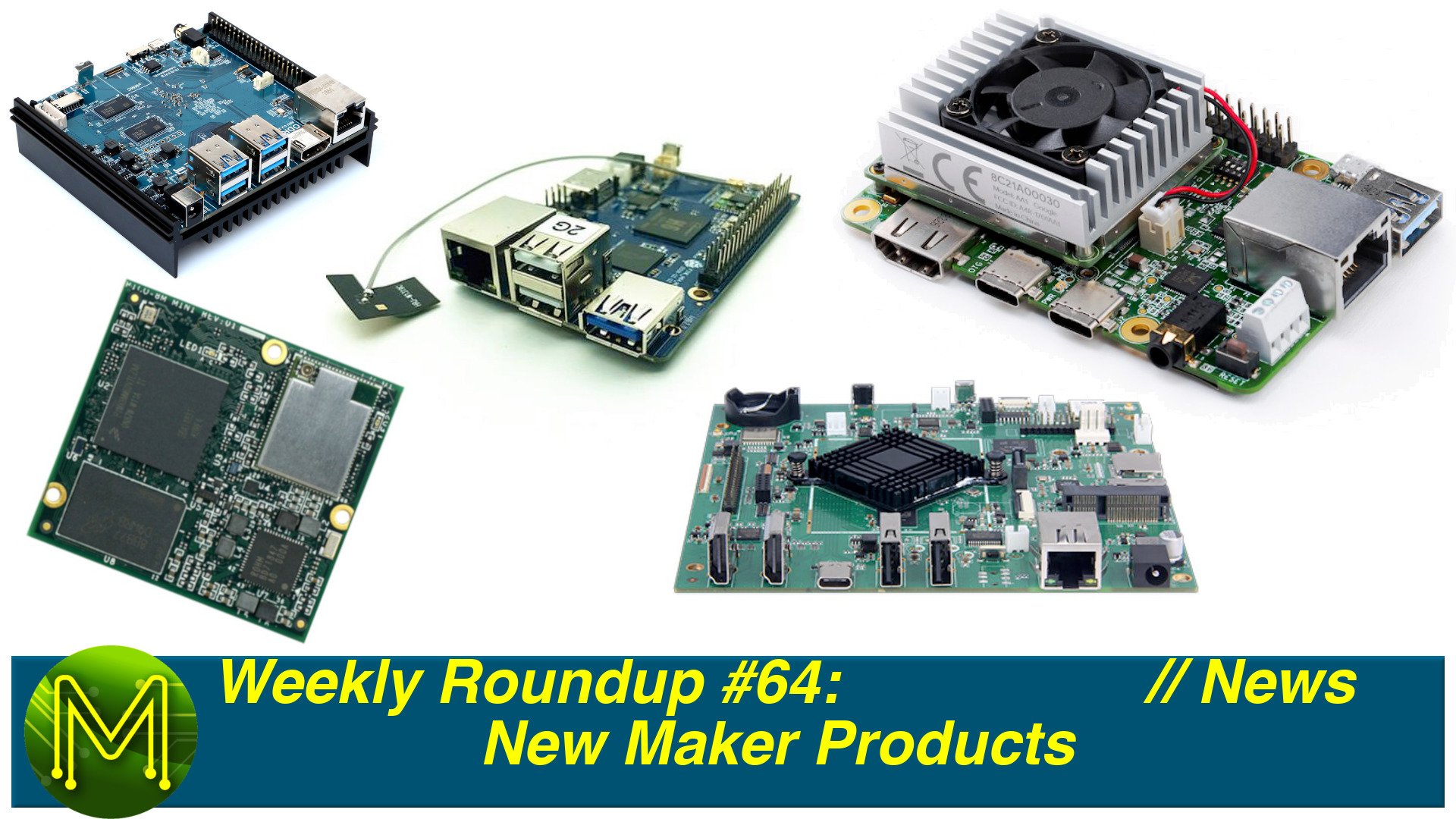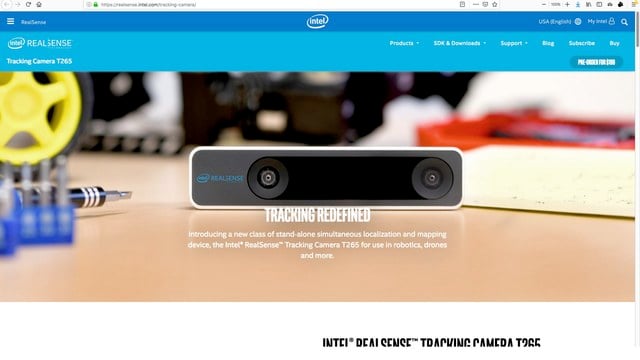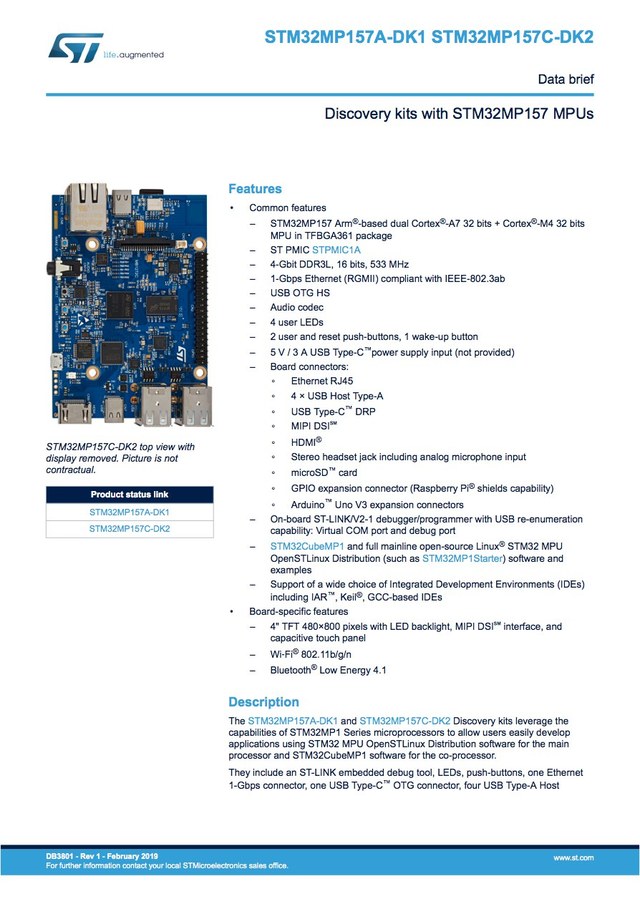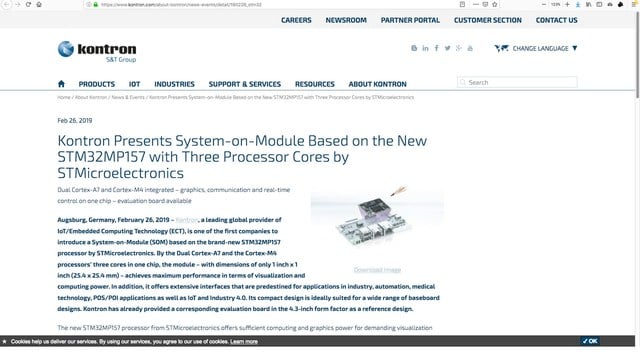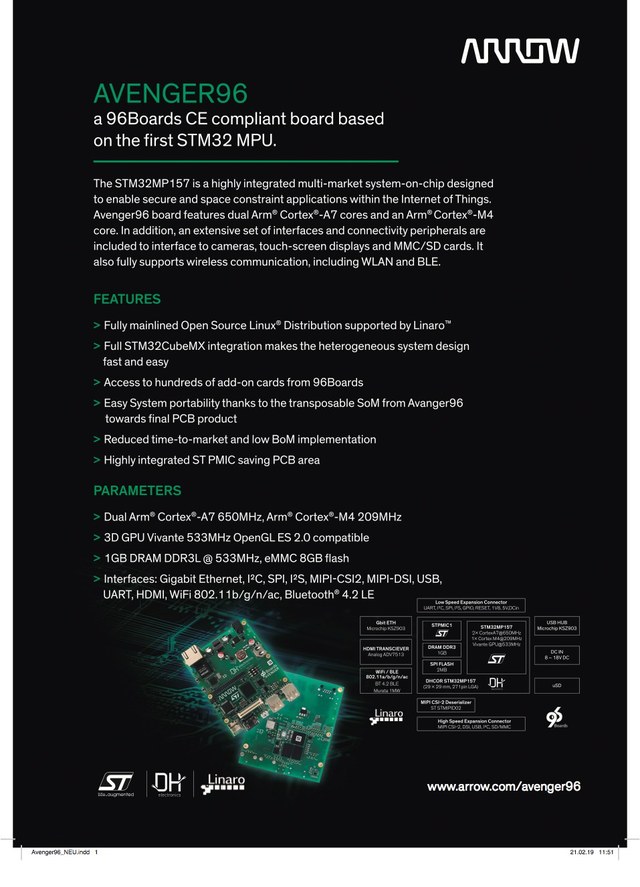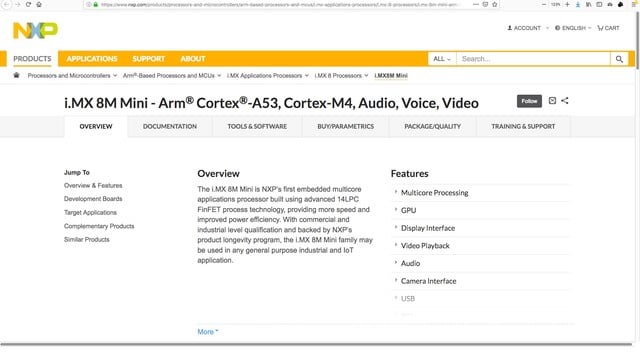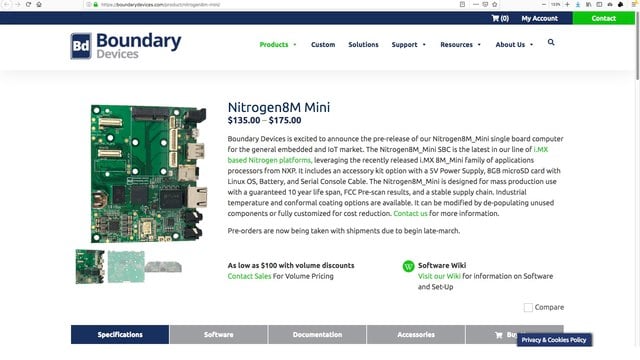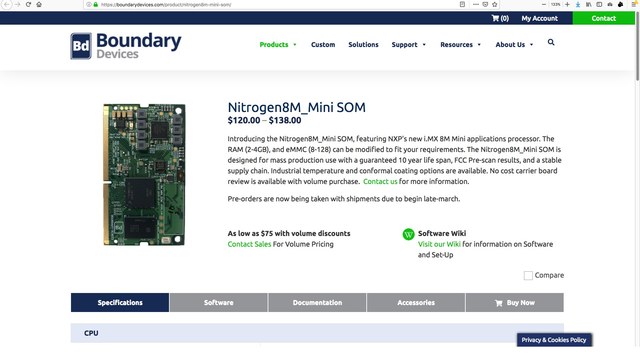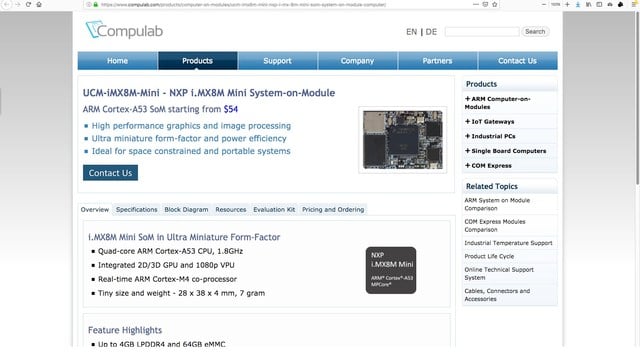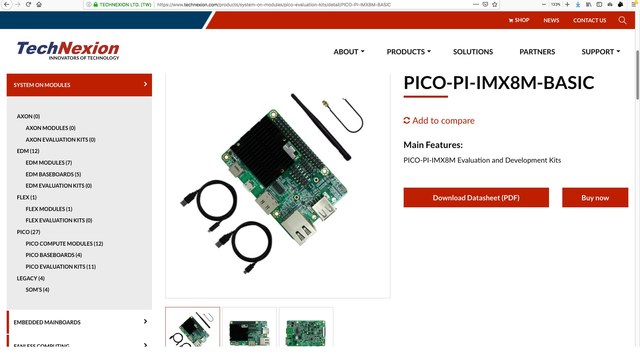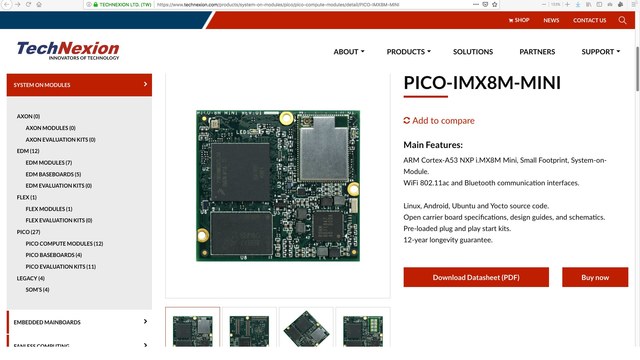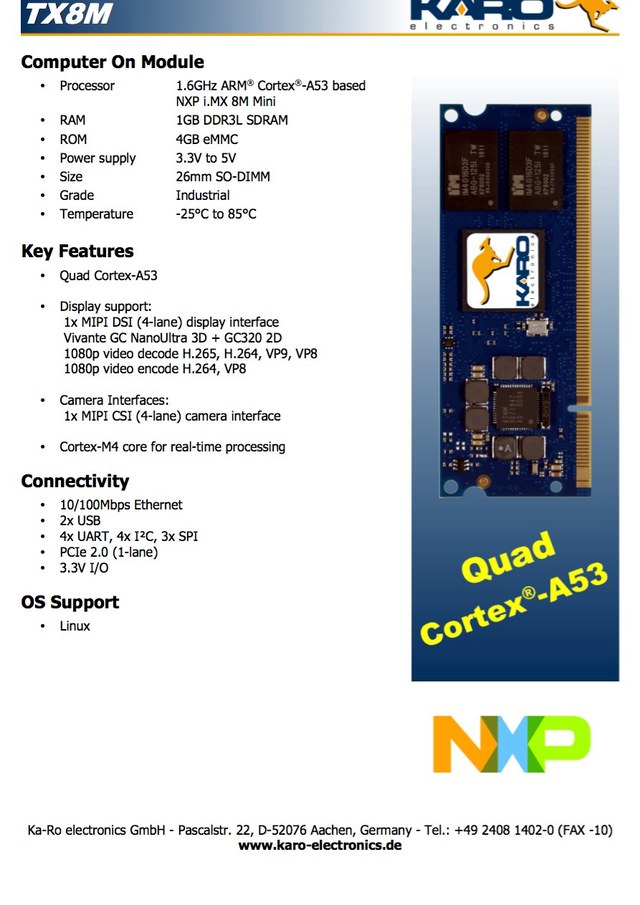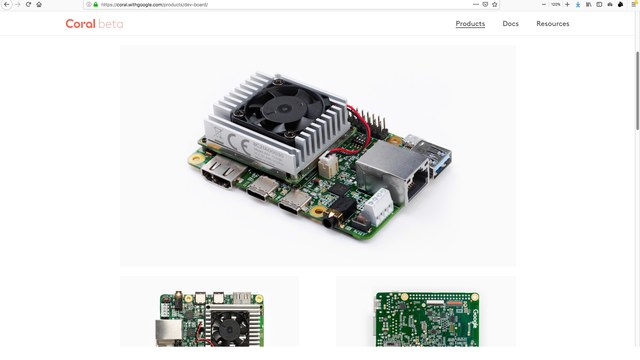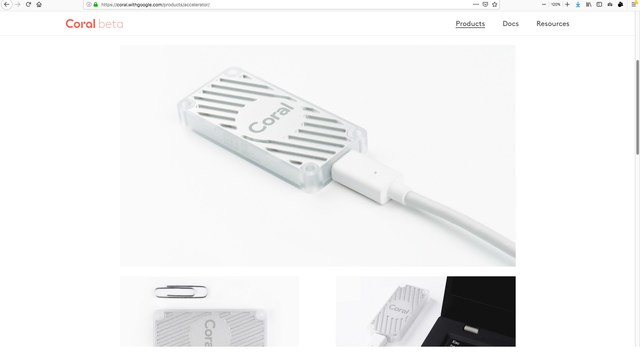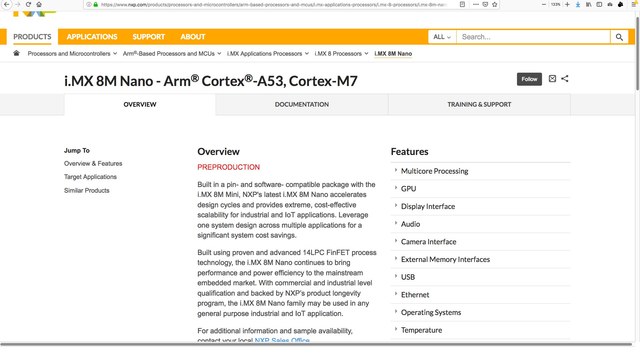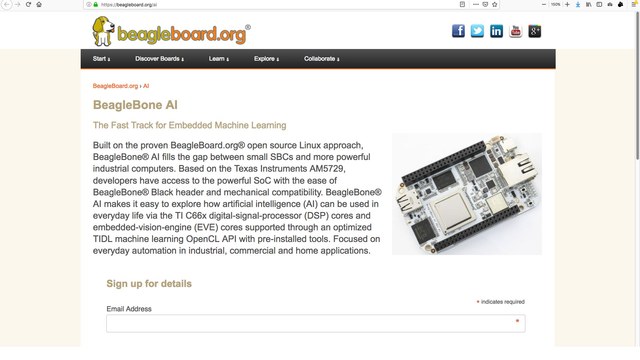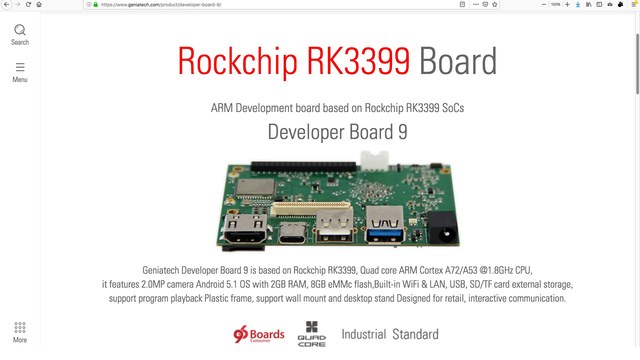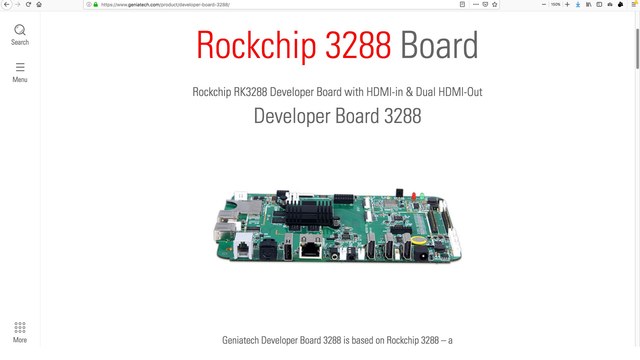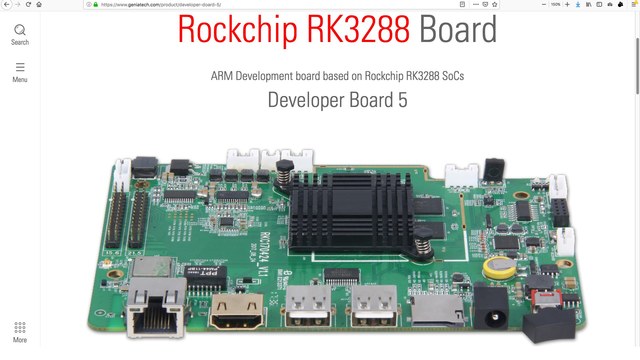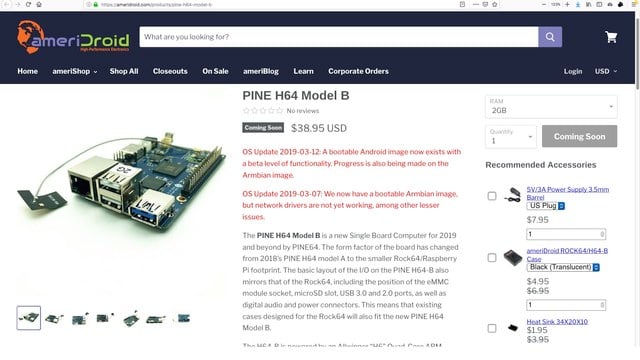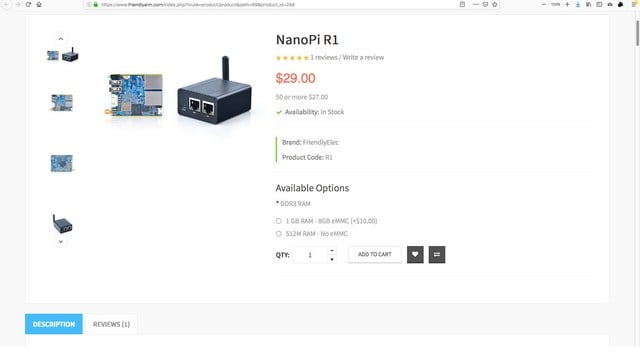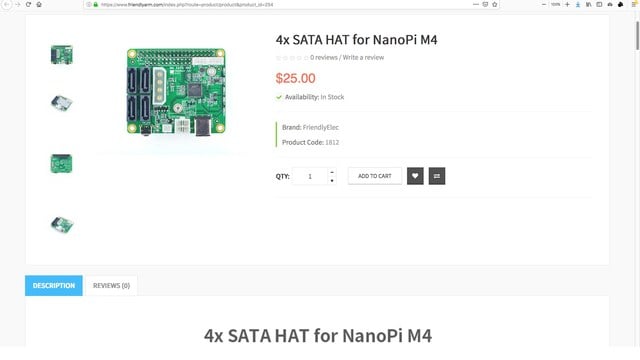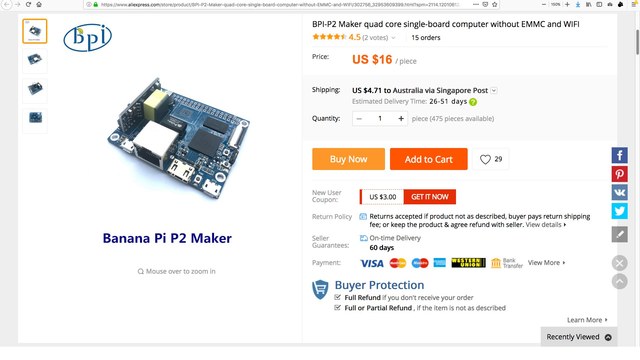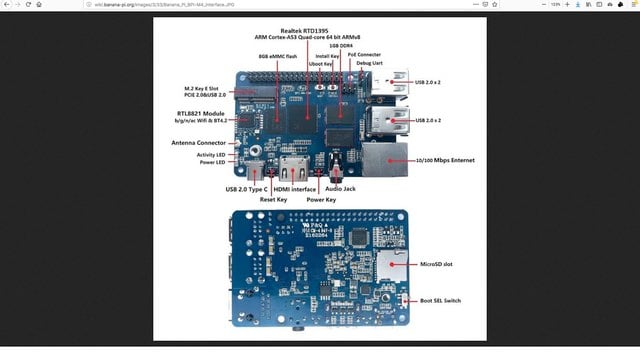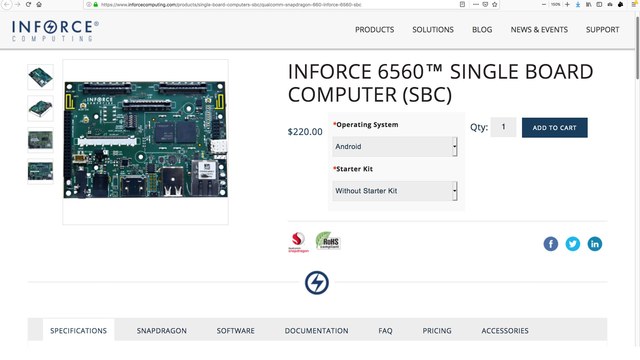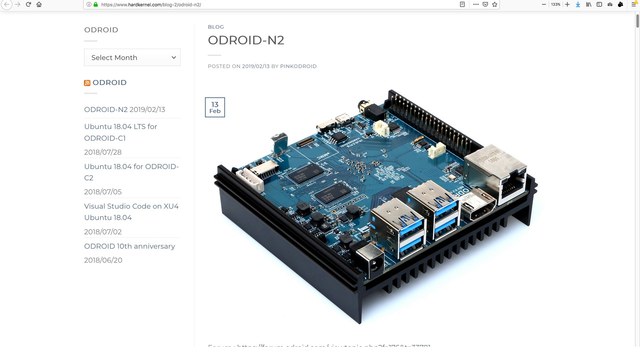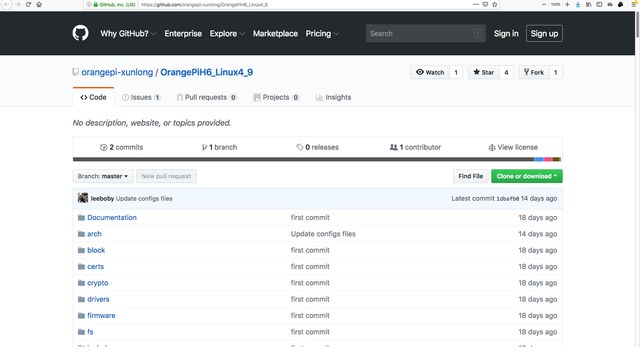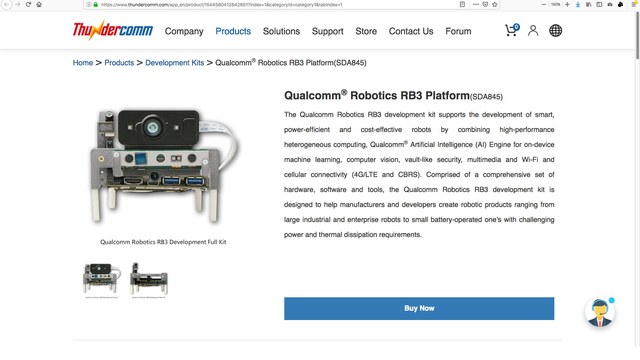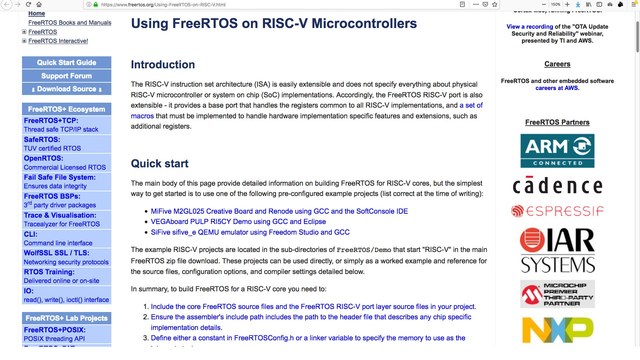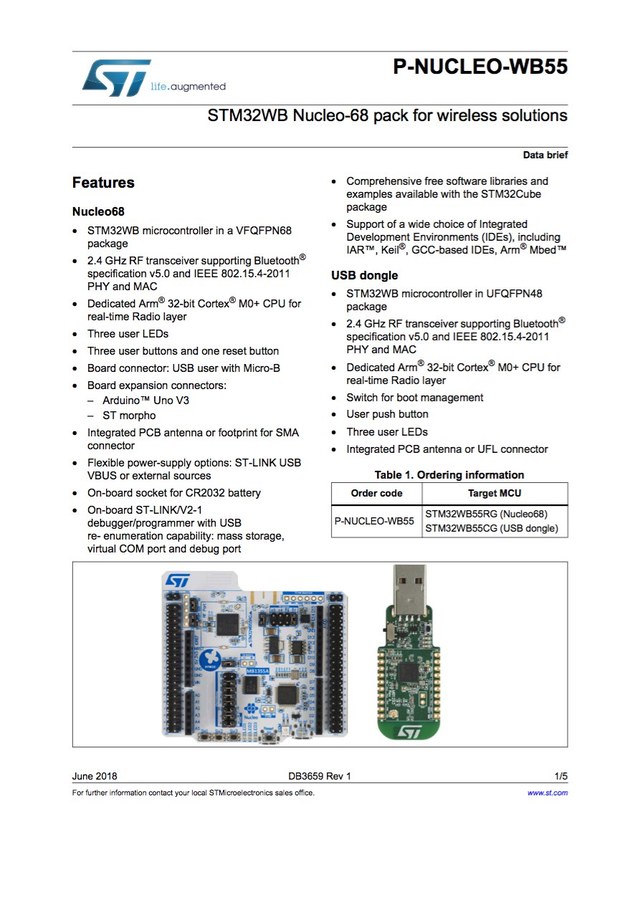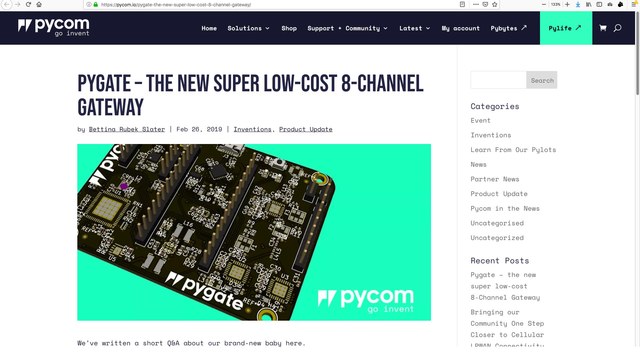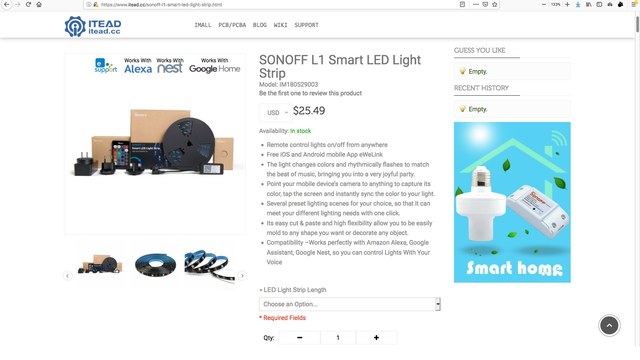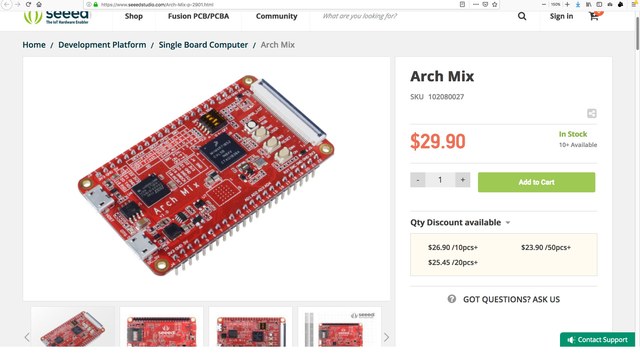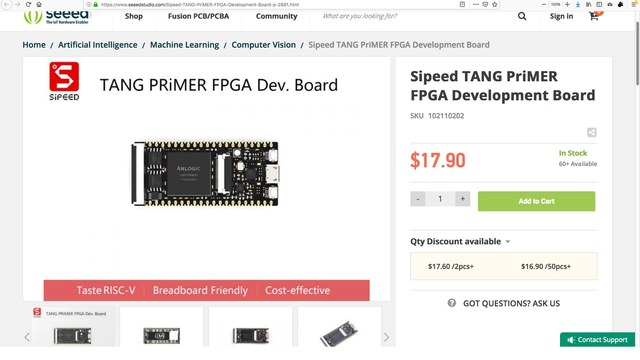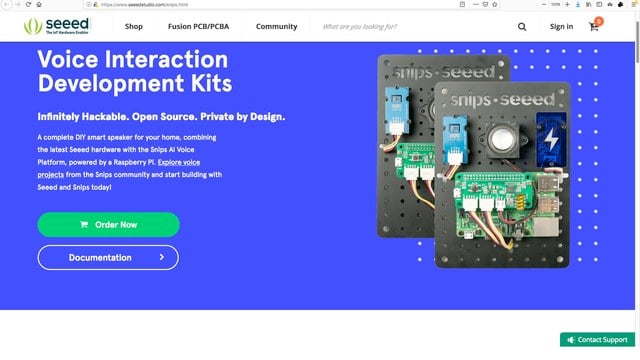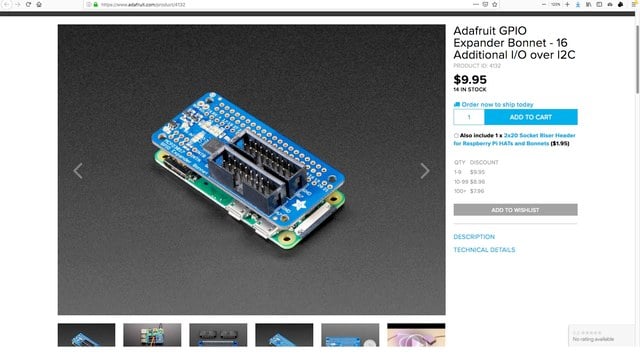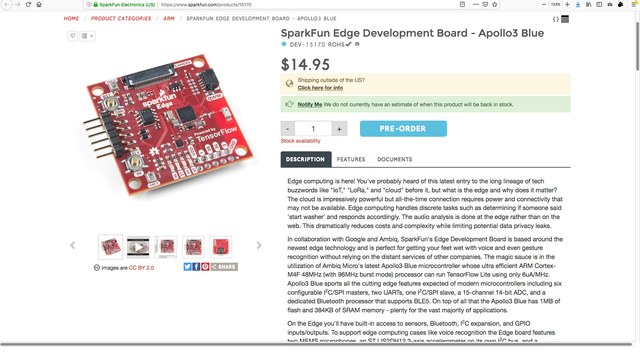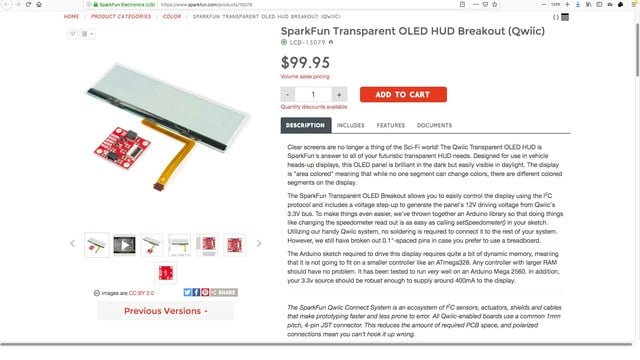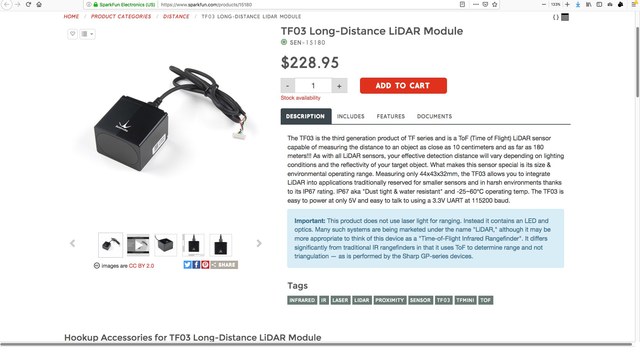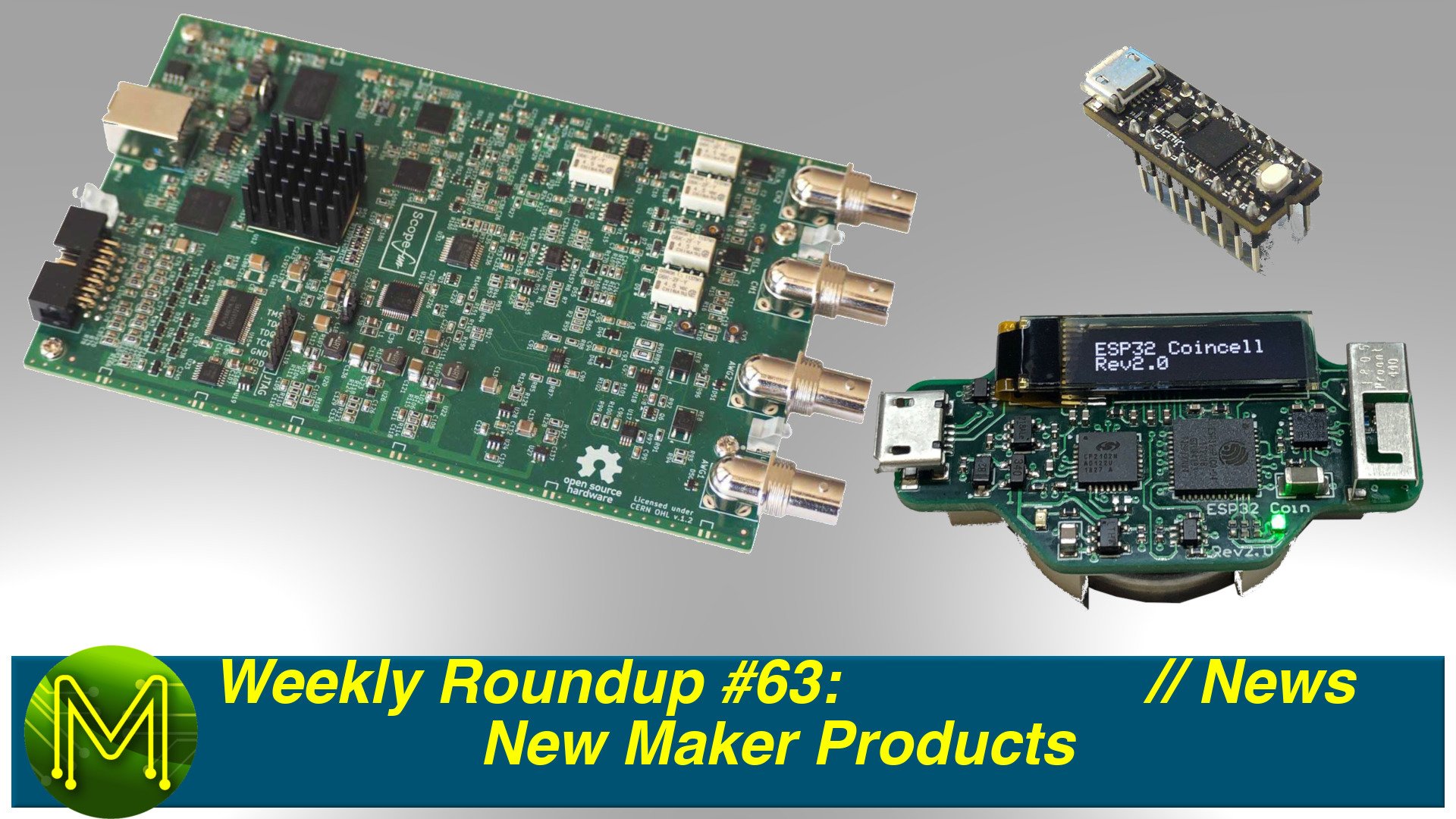Weekly Roundup #64 - New Maker Products
So much has happened recently that the Roundup of New Maker Products is split into two. This is all the rest of the stuff. So, go and hide your wallets!
On The Interwebs
Intel Tracking Camera T265
After seemingly pulling out of the Maker scene entirely, Intel are back with their T265 RealSense Tracking Camera. This new camera has some pretty decent specs. The unit has- USB3.1 port for interfacing
- two 170 degree FoV cameras
- 6DOF IMU
- is powered from an Intel Movidius Myriad 2 VPU
- only consumes 1.5W at full throttle
Intel also claims that it provides 6mS latency between movement and reflection, so is fast enough for Augmented Reality applications. This is a tiny unit and at US$199 a pop, is pretty tempting.
STM32MP1
Over at STMicro they are wedging their foot in the Linux door a little bit more with the release of the STM32MP1 SoC.This is a chip that contains an ARM Cortex-M4 real-time processor running at 209MHz and either a single or dual ARM Cortex-A7 running at 650MHz. It supports DDR3 RAM running at 533MHz, and Quad-SPI, NAND and SDMMC flash memory interfaces. There’s also the usual plethora of interfaces such as GbE, HDMI driven from a 3D GPU, CAN, USB, MIPI-CSI & DSI, USB, as well as some decent security supporting encryption and secure boot.
Along with the release of the SoC, they have also released two evaluation boards.
There’s the more expensive board that breaks out pretty much every feature of the SoC with 1GB DDR3 RAM, USB Type-C, an on-board ST-LINK programmer and a whole bunch of other stuff I’m not going to mention. Really, there’s everything there.
Or for US$300 less you can pick up this evaluation board which removes a lot of the more expensive items and has only 512MB RAM, but is still quite usable.
Kontron tiny STM32MP157 module
While we’re on the topic of the new STMicro SoC… Over at Kontron, they casually mentioned an upcoming tiny module based on the STM32MP157.The 25.4mm square PCB has 512MB RAM, 2MB NOR flash, 512MB NAND flash and castellated edge connectors breaking out two 100MbE ports, two USB2.0, 8 UARTs, 2 CAN, SDIO, parallel RGB and DSI display outputs, as well as a bunch of GPIOs. Pretty impressive little board that was being shown at Embedded World 2019 this year.
Shame that there’s been no update since.
Arrow Avenger96
And not to be outdone by Kontron, over at Arrow they have the Avenger96. This isn’t anything to do with Marvell, rather a 96boards complaint SBC.It has 1GB DRAM, 8GB eMMC, SD slot, HDMI out, GbE, USB ports and the typical low and high speed 96boards headers.
But looking at the underside of the board, this seems to be just a baseboard for a module, which is being produced by a company called dh-electronics. It has a very similar lineup to the Kontron module and about the same size, but instead of castellated edge connectors, has a 271 pin LGA underneath. So hand-soldering is out of the question here.
NXP i.MX 8M Mini SoC
On the other side of the fence, there’s a bunch of new SBCs being released based on NXP’s i.MX 8M Mini SoC, which has a quad-core Cortex-A53 running at 2GHz, real-time Cortex-M4F and 2D and 3D GPUs. It’s based on a new 14nm silicon process that reduces thermal and power issues when running at faster clock rates. The Cortex-M4F can wake up the Cortex-A53, so this SoC has some decent low power capabilities.Nitrogen8M_Mini SBC
Boundary Devices have released the Nitrogen8M Mini, that has 2 or 4GB DDR4 RAM, 8 or 128GB eMMC, SD slot, PCIe, GbE, WiFi, Bluetooth, audio in/out, RTC, the usual lineup of GPIOs, MIPI-CSI and DSI, but sadly no HDMI, LVDS or LCD RGB interfaces.Nitrogen8M_Mini SOM
They also have a SoM that has pretty much the same lineup as the full SBC, but with 2GB RAM and 8GB eMMC flash and, of course, lower price.Arrow AI-ML and Thor96
Back in the Arrow camp, they have two new SBCs.The AI-ML not only has the i.MX SoC, but 2GB RAM, SD slot, HDMI and MIPI out, GbE, WiFi, Bluetooth, SIM slot, USB 3.0, mPCIe and the usual low and high speed 96boards compliant headers.
Then there’s the Thor96. [Am I the only one to pick up on some sort of Marvell theme going on here?] This mighty board has 2GB RAM, SD slot… oh blah blah… it has the same specs as the AI-ML, but has an additional Zigbee module. No idea on pricing on either of these.
Compulab SOMs
Not to be out-done by tiny things, Compulab have released a 38 by 28 mm module based on the i.MX8M Mini.This module has up to 4G DDR4 RAM, up to 64G eMMC flash, WiFi, Bluetooth and pushes out GbE, PCIe, MIPI-DSI & CSI, SDIO, I2S, UART and a whole bunch of GPIOs onto two 100pin headers, which they don’t have a picture of,
but it’s there as you can chuck this module onto their baseboard, which breaks out everything onto physical connectors.And a proper USB3.0 port and DC jack! Nice.
TechNexion modules & SBCs
Over at TechNexion they decided to one-up everyone else by releasing a bunch of new products based on the i.MX8M.There’s the Axon-Pi, which has a very familiar footprint, but breaks out GbE, MIPI-CSI, HDMI, USB and seems to be powered from USB Type-C. It also has 1G DDR4 RAM, 8GB eMMC flash, WiFi, Bluetooth and an i.MX8M based SoM. This SoM has everything I mentioned before contained on it.
So the Axon-Pi essentially just breaks out connectors and provides proper power management. It’s slightly bigger than the previous i.MX8M modules coming in at 37 by 40 mm.Then there’s this module that’s very similar to the previous in terms of specs, but with a DIMM style edge connector.Ka-Ro TX8M
Jumping over to Germany, they’ve come out a similar 200pin SO-DIMM style module called the Ka-Ro. Which has nothing to do with our mode of transport down-under.This board runs with 1G RAM, 4G eMMC flash and breaks out all the important stuff like, MIPI-DSI & CSI, 100MbE, USB, PCIe, and a swag of UARTs. Nice.
Google Coral
And to show that they mean business… Google have come out with their first SBC called the Coral.This has an Edge TPU module, running an NXP i.MX 8M SoC, Google Edge ML accelerator for TenserFlow, 1G DDR4 RAM, 8G eMMC, WiFi, Bluetooth and pushes out almost everything else on to a 300 pin connector. The base-board then breaks out SD slot, USB everything, with USB Type-C for power, nice, GbE, HDMI, MIPI-CSI & DSI, audio, and Raspberry Pi header, and I bet it really is fully Pi compatible, but won’t really know until I have one in my hot little hands.
But wait, that’s not all, Google have also released the Coral USB accelerator, which has an Edge ML accelerator, ARM Cortex-M0 to control things a bit and of course USB 3. Designed to enable drop in access to Google’s TenserFlow.If you’re in the US you can currently pick these boards up from Mouser - the USB accelerator for US$75 and the Coral for US$150. Bear in mind that these products are restricted and you can only buy within the US.
NXP’s i.MX8M Nano
While we’re on the NXP SoCs, they have also just released the i.MX 8M Nano.This SoC lowers the clock rate of the Cortex-A53 cores to 1.5GHz, but uses a faster Cortex-M7 core running at 600MHz. It doesn’t have any hardware video CODECs. So, is designed for low power applications. Apart from that everything else is the same.
BeagleBone AI SBC
It’s been a while since we’ve heard from the BeagleBone guys.Well, they’ve just released a new SBC called the BeagleBone-AI. This is based on a Texas Instruments AM5729 SoC, which is a competitor to Google’s AI and Deep Learning technology, and runs a dual-core Cortex-A15, dual-core C66x DSP and quad-core Embedded Vision Engine. The SBC also has 1G RAM, 16G eMMC flash, GbE, USB Type-C for data and power, (thankfully), and the all-familiar BeagleBone headers.
5 new Geniatech SBCs
Back in the RockChip camp we have a new SBC from GeniaTech.
First up there’s the DB3399Pro. This, of course, runs the RK3399Pro hexa-core SoC, with either 3 or 6G DDR3 RAM, 8, 16 or 32G eMMC flash, GbE with PoE support, WiFi, Bluetooth, 6 USB2.0, 1 USB3.0 & USB Type-C ports, mPCIe, HDMI out and yet another board with HDMI in, DIsplayPort, eDP and a GPIO header. This is the second board we’ve seen with HDMI in capability, but I can’t see how it’s providing it. Once I have some more detail, I’ll publish to my website.This board compliments the lineup of other RockChip based SBCs:
Such as the Developer Board 3399, running the RK3399 with 2G RAM, 8, 16 or 32G eMMC flash, dual HDMI, DP, eDP, WiFi, Bluetooth… really pretty much the same line-up as the DB3399Pro in terms of I/O options, but with a full size SD slot.Then there’s the Developer Board 9, which is a smaller footprint version of the previous board and only supporting 8G eMMC flash with a footprint of 155 by 105 mm.Then there’s the Developer Board RK3288 which, of course, runs the RK3288 SoC with 2G RAM, 8, 16 or 32G eMMC flash and pushes out dual HDMI out, HDMI in, MIPI-DSI, eDP, DP and unusually CVBS. There’s also this connector, which I haven’t been able to find any info on. If you find out let me know in the comments below or the MickMake forums. Looks pretty interesting.Then there’s the Developer Board 5, which is more of the same, but cutting back to one HDMI out, two USB ports and audio interfaces, but it does have a funky old style toggle switch for power! Look at that.Pine H64 Model B
The Pine64 guys are back with another SBC in a now classic Raspberry Pi form factor.This one sports the Allwinner H6 quad-core Cortex-A53 running at 1.8GHz with 2 or 3G DDR3 RAM, 16MB SPI flash, eMMC socket, SD slot, USB3.0 & USB2.0 ports, WiFi, Bluetooth, GbE and of course HDMI out. Power is via DC jack… nice… and there’s no PCIe which is a good thing really. I don’t know of anyone getting PCIe going on the Allwinner H6. Oh, there’s also a “maybe compatible” GPIO Pi header.
MapleBoard MP130 Allwinner H3
Another Taiwanese company is dipping it’s toes in the SBC market with the MapleBoard MP130.This runs the AllWinner H3 SoC, with 1G DDR3 RAM, 8G eMMC flash, SD slot, USB2.0, HDMI, 100MbE, audio in/out and the low and high speed 96boards compliant headers. Although it seems you can also purchase a cheaper version without these headers. Power is via DC jack and also has soft power and reset buttons.
FriendlyARM NanoPi R1
Heading over to the Friendly guys, they have the NanoPi R1.This is a small SBC running the Allwinner H3 with 512M or 1G RAM, optional 8G eMMC flash, SD slot, 2 USB ports, WiFi with SMA connector, Bluetooth, GbE and 100MbE ports. There’s also headers for UART and RTC battery. It comes in a snazzy enclosure providing access to Ethernet, USB, power and external WiFI antenna. As you probably have guessed by now, it’s aimed to be used as a gateway router, so FriendlyARM have provided images for OpenWRT.
You can pick up the eMMC version for US$39 and the one without for US$29. So, bang for your buck is pretty good.
NanoPi M4 SATA board
As mentioned in my NanoPi M4 review video, we were waiting for FriendlyARM to release a SATA hat for the M4.Well, they’ve done just that and this board breaks out 4 6Gb/s SATA ports. They’ve even produced some benchmarks using iozone against various storage technologies and there’s no disappointment there. Of course, you’re not going to see the speeds of NVMe, but hey, for that price… I’m not complaining.
When bolted on top of the M4, it looks like a pretty compact and neat unit.
Banana Pi P2 Maker
Back in Weekly Roundup #56 we saw the Banana Pi 2 Zero. It was supposed to be a direct competitor to the Raspberry Pi Zero, but was still a little pricey.Well, the Banana guys have released another version called the Banana Pi 2 Maker, which is identical to the Zero, except it drops the eMMC module and eMMC flash. It still supports PoE modules and you can still replace the dodgy microUSB power connector with a DC jack.
Apart from that it’s the identical.
Banana Pi M4
They’re also thinking about releasing a new SBC called the Banana Pi M4. Not to be confused with the NanoPi-M4, this board actually runs the Realtek RTD1395 SoC which is a quad-core, Cortex-A53. It comes with either 1 or 3G RAM, 8, 16, 32 or 64G eMMC flash, SD slot, a nice M.2 Key E slot, WiFi, Bluetooth, 100MbE that supports any standard Pi PoE hat, USB Type-C, nice, and all the usual GPIO mod-cons.It’s a promising board. It’ll will be interesting to see how they handle logic level conversion of the RTD1395 SoC and how it stands up under my testing once I get my hands on one.
Inforce 6560 SBC
If you’re looking for a bit of stereoscopic video grunt, then there’s the Inforce 6560 SBC.This runs the Qualcomm Snapdragon SDA660 which is SoC with 8 core Kyro CPUs running at 2.2GHz, an Adreno 512 GPU, Hexagon 680 DSP for computer vision processing and a Spectra 160 dual camera image signal processors supporting a single 24MP or dual 16MP cameras. There’s also 3G DDR4 RAM, 32G eMMC flash, SD slot, USB 3.1, GbE, WiFi, Bluetooth, HDMI, as well as 4K out on USB Type-C. It also has GPS, 9 DOF IMU and GPIO expansion header.
Coming in at US$220, that’s also pretty decent bang for your buck.
ODROID N2
The HardKernel guys have now announced details of the ODROID-N2.This runs the Amlogic S922X SoC built on 12nm silicon technology. It has quad-core Cortex-A73 and dual-core Cortex-A53 processors. The A73 cores run at 1.8GHz which HardKernel claim they see no thermal throttling using a stock fanless heatsink.
They also claim 20% faster overall CPU performance, 35% faster RAM speeds when stepping up to DDR4 RAM. So, a bit of a step up and will be really interesting to see this perform under real-world tests.
Apart from that we see the usual lineup - 2 or 4G RAM, 8MB SPI flash, eMMC flash socket, SD slot, 4 USB3.0 ports, HDMI out, as well as composite out, RTC header, PWM fan control if you want it and the usual 40 pin Pi header thingy. Power is via DC jack, thank goodness, and this little baby draws only 1.8W when idle and 5.3W under CPU load.
Nice.
Orange Pi H6 kernel 4.9
Over at cnx-software Jean-Luc let us know about some new Orange Pi O/S image releases.There’s an Android 9 release for the Orange Pi One Plus, which supports Linux kernel 4.9.118. This is a welcome relief for anyone using that SBC as support for it was fairly poor.
There’s also an update for the Orange Pi RK3399, with kernel 4.4.103 and an update for the Orange Pi 4G-IoT.
This is all pretty important stuff as the Linux kernel 4.x series is starting to look a little old.
Linux 5.0 released
Speaking of the Linux kernel…Last month we saw Linux kernel 5.0 being released. This is one really nice update for anyone playing around with SBCs. This merges into mainline official support for a couple of new architectures and filesystems.
SoCs running the big.LITTLE architecture, which is almost all SoCs these days, now has an Energy Aware Scheduling option which allows tasks to wake up on the more energy-efficient CPUs first.
There’s also massive changes across all SoCs; AllWinner, Qualcomm, Mediatek, Amlogic, Samsung & RockChip. This last one will be interesting as one of my subs, (Nigel), mentioned I should retry my tests on the Orange Pi RK3399 using kernel 5.0.
There’s also new architecture support from NXP, Marvell, Renesas, and C-SKY. So, some really big changes for the ARM world.
Qualcomm® Robotics RB3 Platform
If you’re in to robotics, then Qualcomm have released a Robotics RB3 Platform. This is a US$449 kit, which sounds a little pricey, but for that you get a new 96boards complaint DragonBoard 845c SBC running an octo-core Snapdragon 845 at 2.8GHz, 4G DDR4 RAM, 64G UFS storage, SD slot, USB3.0, GbE, WiFi, Bluetooth, GbE, HDMI, MIPI-DSI and a bunch of GPIO options pushed on to 2 high speed and 2 low speed 96boards compliant headers.As part of the kit you also get a Qualcomm Spectra 280 camera with dual ISP connectors to the main board. So, once again, bang for your buck is good.
FreeRTOS Now Supports RISC-V
FreeRTOS now supports RISC-V, which is a good thing. It’s something that has been lacking for long time and will pave the way for an even faster adoption of the RISC-V architecture.STM32WBx5
Not being satisfied enough with the launch of the STM32MP1 SoC, STMicro have also released a Bluetooth IC.The STM32WB runs a Cortex-M4 running at 64MHz and a Cortex-M0+ running at 32MHz. Applications written for this IC will run on the Cortex-M4 with the Cortex-M0+ handling the comms side. You also get 256KB RAM, 1MB flash, but also a quad-SPI interface for more storage.
There’s a bucket load of on-board encryption support and you also get 72 GPIOs ranging from USARTs, USB, ADC, SPI, I2C and others with almost all of the GPIOs being 5v tolerant. That’s a big bonus for people wanting to use this in mixed logic-level environments.
Power is from 1.71 to 3.6v and has various sleep modes getting this IC down to 13nA in shutdown mode, 600nA in standby mode running the RTC and 2.1uA in halt mode and RTC. That’s some pretty serious low power options.
Pycom Pygate
If you’re in to LoRa, or want to look into setting up your own LoRaWAN gateway, then this might interest you.PyCom will soon come out with the PyGate, which is a low-cost 8-channel gateway that can connect to LoRaWAN or PyCom’s PyMesh networks. It runs two SX1257 transceivers along with a Semtech SX1308 baseband processor and supports LiPo battery charging via USB or PoE based Ethernet using a daughter-board along with ultra-low power standby modes. Access is via a USB to serial bridge.
Pricing is around 50 euros, which is pretty good for what you’re getting.
Omega2 wireless LiDAR
Another one for robotic fans. The Onion Omega guys have come out with an uber cheap full 360 degree LiDAR kit.For the US$199 price tag, you get an Onion Omega2+ board, Power Dock 2 and Delta2B LiDAR which can scan at 5000sps with a range of 200mm to 8m, scan rate of 600 RPM and resolution of 0.25mm.
Now that’s a pretty decent bang for your buck as well.
AdaFruit, Seeed, SparkFun, DFRobot, DigiKey
Sonoff L1 Smart LED strip
Over at ITEAD they have the new Sonoff RGB LED light strips. Like all the Sonoff devices, you can connect it to Google Home or Alexa, or control using the Ewelink smartphone app and control any of the LEDs along the 2 or 5M IP65 rated waterproof lengths. Pretty cool.Arch Mix
The i.MX RT is another semi from NXP which is a hybrid MCU and SoC. It runs a 600MHz ARM Cortex-M7 processor providing real-time capabilities that you see in MCUs, but also runs a Linux kernel. So you get the best of both worlds.
Seeed Studio has the Arch Mix, which not only runs an i.MX RT1052 SoC with 32MB RAM, but also has 64MB flash, 8MB SPI flash, SD slot, two USB ports, parallel RG888 LCD interface similar to that present on the BeagleBone and Raspberry Pi, RTC battery header and 44 pins of GPIO goodness.If you want to play around with these SoCs, it’s a cheap way to do it.
Sipeed Lichee Nano
Back in Weekly Roundup #58 we saw the Lichee Nano, which is a tiny board SBC based on the AllWinner F1C100. This board has very similar specs to the Arch Mix with a real-time capable SoC, but you can pick it up from Seeed Studio for only US$8! Nice.Sipeed TANG FPGA
Back in the same Weekly Roundup we also saw this FPGA board, which is another low-cost entry point into the world of FPGAs. Running the not so popular Anlogic Technologies EG4S20 FPGA capable of 20K LUTs with 130KB static-RAM, 64Mb dynamic-RAM, 8Mb flash, a castellated PCB pushing out 40 GPIOs and an FPC interface for connecting displays and cameras.Sipeed MAix Go Suit
Back in Weekly Roundup #61 we saw the Sipeed MAIX running the 800MHz Kendryte K210 SoC. It’s an interesting IC with a dual-core RISC-V processor, Field Programmable IO Array, neural network and audio processor supporting 8 mics at 192KHz.
Well, you can now pick up this HAL9000 looking unit with on-board camera, mic array, speaker, LCD, thumbwheel, SD slot, 48 GPIOs broken out on two headers and full LiPo battery management and you get all this for only US$41!Seeed Snips
The Snips AI Voice Platform is an AI framework for those who are more security conscious. It allows full off-line voice recognition similar to that provided by Google, Amazon and Apple. Of course, it’ll require a little more work, with voice training required, but comes with a voice training assistant to reduce training time. You can pick up one of these kits from Seeed for US$115, which includes a Raspberry Pi 3, ReSpeaker hat, temperature & humidity sensors, relay PCB and acrylic sheet to mount everything.Adafruit GPIO Expander Bonnet
Over at AdaFruit you can pick up a GPIO expander hat based on the MCP23017, which is a 16 port GPIO expander controlled over I2C. This IC isn’t capable of PWM, but any of the pins can be set as an input or output, with internal weak pullup or pulldown resistors.Pimoroni Keybow
You can also pick up a Pimoroni Keybow, which is a Pi Zero hat providing 12 programmable membrane style keys. Each key also has an RGB LED underneath allowing visual feedback of key presses.SparkFun Edge
Over at SparkFun they’re stepping up their AI game as well with an Edge dev board.
This runs the little known Ambiq Micro Apollo13 Blue MCU that is powered by a Cortex-M4F MCU running at up to 96MHz. It also provides Bluetooth 5, has 1MB flash and 384KB RAM and spits out all the usual GPIOs. This MCU is capable of running TensorFlow Lite requiring only 6uA per MHz. So, is a very cheap entry point into voice AI. The PCB provides headers for an OV7670 based camera, JTAG and Qwiic and also has a 3DOF IMU, 2 MEMS mics and a few LEDs.The whole thing is powered from a 1.8 to 3.6v DC supply, or coin cell battery.
Transparent OLED HUD
If you want to get into Heads Up Displays, then you could probably do it with this. It’s simply an OLED display without any backing, but according to SparkFun is easily visible during daylight. Note that this isn’t a graphic OLED, but has predefined areas that can be lit up. Access is over I2C and there’s an Arduino IDE library for it. However, it will require an MCU with a fair bit of RAM, like the ATMega2560.TFMini Plus - Micro LiDAR
Here’s another cheap LiDAR module. It’s much cheaper than a “real” LiDAR because it uses a Time-Of-Flight rangefinder. So accuracy isn’t as good, detecting objects up to 12m away with a 1% accuracy, but at that price is good enough. Access is over UART or I2C with 5v power and logic levels. It’s all contained within an IP65 rated enclosure, which is most robust than anything you’re connecting to it.TF03 Long-Distance LiDAR
However, if you want a more expensive version, then this one is capable of detecting objects up to 180m away. It’s still based on a Time-Of-Flight sensor and powered from 5v with access over 3.3v logic level UART.The following content is password protected.

